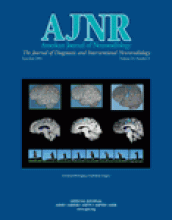Abstract
BACKGROUND AND PURPOSE: Hydrocephalus causes transependymal resorption of spinal fluid that in turn produces periventricular interstitial edema. This study was performed to determine if diffusion imaging can demonstrate this interstitial edema in the periventricular region in patients with obstructive hydrocephalus and if it can be used to assess the treatment response.
METHODS: Twenty-one patients with obstructive hydrocephalus were evaluated with MR diffusion imaging before and after treatment. The change in ventricular size was measured by using the frontal and occipital horn ratio. The signal intensity abnormalities in periventricular white matter were scored. Average diffusion constants (Dav) in the periventricular white matter were measured before and after treatment and compared with normal values. Post-treatment resolution of MR imaging abnormalities and changes in ventricular volume were compared with changes in Dav.
RESULTS: Dav measured from periventricular white matter was increased in hydrocephalic patients compared with age-matched control subjects by a mean of 6.9% (P < .02). After treatment, Dav decreased by an average of 6.0%: Dav decreased in 11 patients (53%), it remained essentially unchanged in seven (33%), and it increased in three (14%).
CONCLUSION: For patients with obstructive hydrocephalus, diffusion is usually increased in the periventricular white matter. Therefore, increased Dav may be a clinically useful sign of hydrocephalus, and it may prove useful in cases with equivocal clinical or imaging findings. Measurement of Dav may be valuable in assessing the treatment response in these patients because Dav usually decreases toward normal levels with successful treatment.
- Copyright © American Society of Neuroradiology












